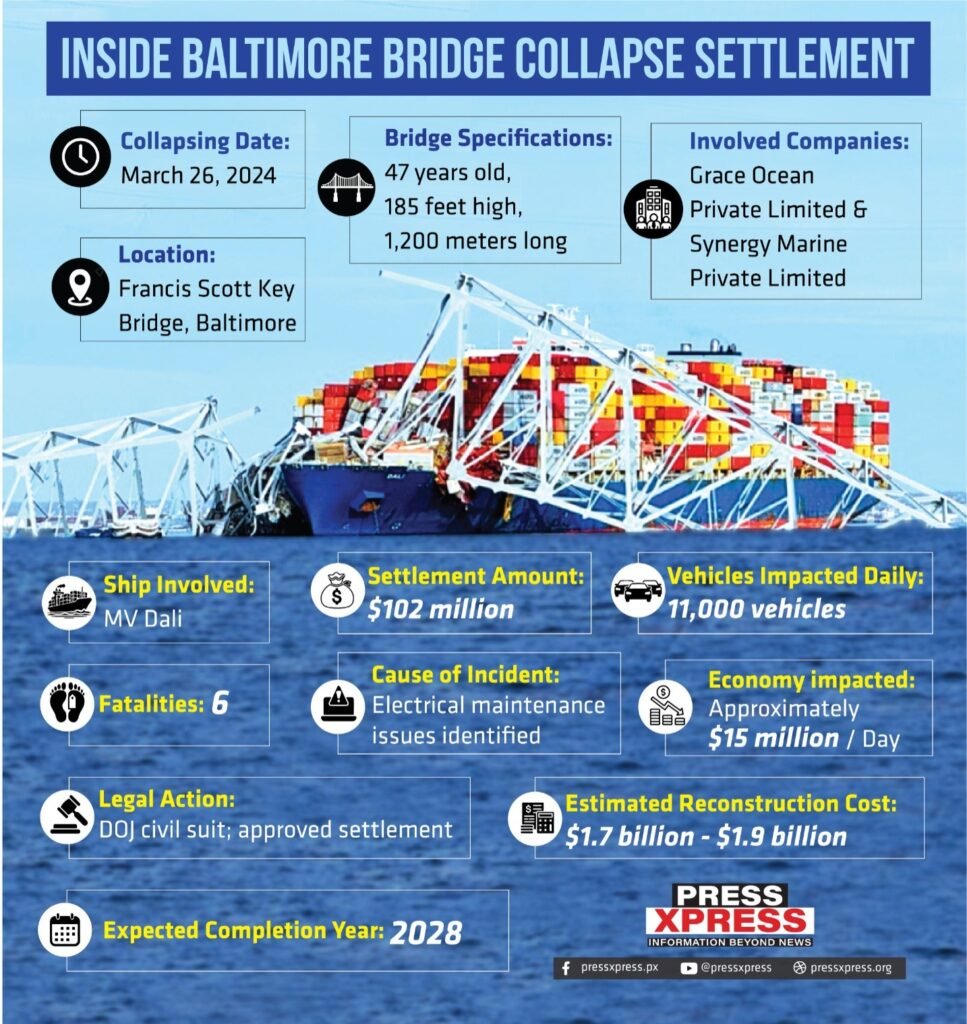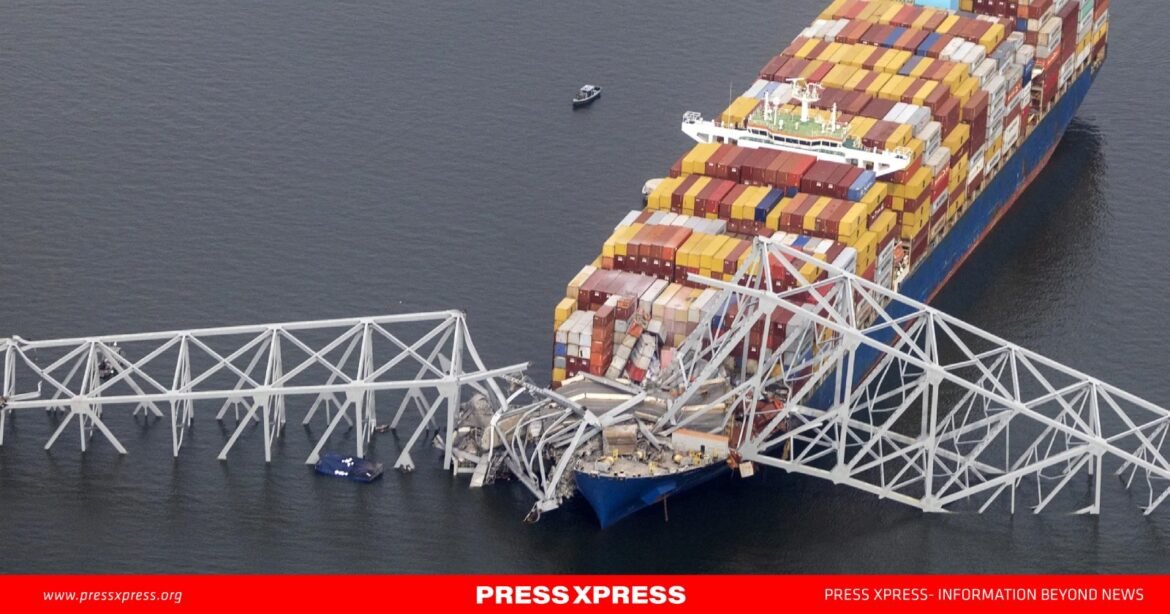In one of Baltimore’s most tragic and costly accidents in recent history, two Singapore-based companies – Grace Ocean Private Limited and Synergy Marine Private Limited – have agreed to pay $102 million to cover cleanup costs after their cargo ship, the MV Dali, collided with Baltimore’s Francis Scott Key Bridge in March 2024. The accident resulted in the loss of six lives and halted crucial maritime traffic for months, causing widespread economic disruption. Now, as the companies settle with the U.S. government, it’s worth looking at what led to this tragedy and what the companies’ payment will cover.

The March Catastrophe
The incident occurred in the early hours of March 26 when the MV Dali, a massive container ship exceeding 100,000 tons, lost power and drifted off course. The ship collided with a bridge support column, causing a section of the bridge to collapse. Tragically, six workers, engaged in routine bridge maintenance, were killed when they fell into the water as the structure crumbled. Although the ship’s crew survived, the accident severely impacted commercial shipping, halting operations at the Port of Baltimore for several months.

The Francis Scott Key Bridge, also known as the Key Bridge, opened in 1977 and stands as a critical transportation link in Baltimore. Spanning 1,200 meters and reaching a height of approximately 185 feet above the Patapsco River, the bridge was designed to accommodate large cargo vessels passing underneath while supporting high vehicular traffic. Before the collapse, the bridge was a vital route for daily commuters and commercial vehicles, with an estimated 11,000 vehicles crossing each day.
Baltimore Mayor Brandon Scott called it an “unthinkable tragedy,” underscoring the event’s devastating impact on the community.
Why Are the Shipping Companies Paying?
The U.S. Department of Justice (DOJ) filed a civil suit in September 2024, alleging that MV Dali’s systems were poorly maintained and that negligence contributed to the disaster. According to DOJ findings, the vessel’s electrical systems were vulnerable to failure due to excessive vibrations, a problem that had been repeatedly patched up but not permanently fixed. Crew members allegedly “jury-rigged” repairs rather than addressing the underlying issue, creating ongoing safety risks.

Investigators found that an independent agency had even stopped electrical testing on the MV Dali due to safety concerns, highlighting a lack of comprehensive maintenance practices. The Justice Department’s lawsuit emphasized the avoidable nature of the accident, alleging negligence on the part of both Grace Ocean and Synergy Marine. Principal Deputy Associate Attorney General Benjamin Mizer stated, “The costs of the federal government’s cleanup efforts in the Fort McHenry Channel are borne by Grace Ocean and Synergy—not the American taxpayer.”
The Legal Basis for the Settlement
U.S. District Judge James Bredar approved the settlement, which allows the U.S. government to recover $102 million to cover the cleanup. However, the companies denied liability, with spokesperson Darrell Wilson stating that Grace Ocean and Synergy Marine do not accept fault but agreed to the settlement to avoid a prolonged legal battle. The companies’ insurance is expected to cover the settlement costs, and punitive damages were not included, leaving open the possibility of additional claims from the state of Maryland, Baltimore City, and families of the deceased.
The legal framework for the settlement is grounded in U.S. maritime and environmental laws, notably the Oil Pollution Act of 1990. Under this act, companies responsible for maritime accidents must bear cleanup costs, aligning with the principle that firms causing public safety hazards cover the financial impact. While this settlement closes the federal claim, further state and municipal claims are anticipated, particularly as Maryland seeks funds to rebuild the bridge.
Maryland’s Financial Challenges
Though the DOJ settlement addresses federal cleanup costs, Maryland’s state government still faces a substantial financial burden. The bridge’s reconstruction is estimated at $1.7 billion to $1.9 billion, with completion anticipated by 2028. The Port of Baltimore, one of the busiest on the East Coast, suffered significant economic disruptions, impacting jobs, local businesses, and families who depend on port operations. Maryland has already filed additional claims to recover rebuilding costs, potentially seeking further compensation from Grace Ocean, Synergy Marine, or their insurers.
Broader Implications: Potential Industry Reforms and Regulatory Gaps
The MV Dali disaster has spotlighted maintenance oversight and regulatory gaps in the maritime industry. Critics argue that foreign-flagged vessels, such as the MV Dali, require stricter inspection protocols and higher maintenance standards to operate in U.S. waters. Industry experts emphasize that while shipping is essential to the global economy, inadequate monitoring creates significant risks. This accident has brought calls for regulatory changes, including more frequent inspections and stronger penalties for companies with a record of poor maintenance.
Lawmakers are considering new legislation to address these maintenance gaps, while insurers are reassessing coverage terms for ships that pose higher safety risks. The MV Dali disaster demonstrated how quickly a localized shipping issue can escalate into regional and even national crises, affecting supply chains and economies well beyond Baltimore.
A Wake-Up Call for the Maritime Industry
With global shipping on the rise, the MV Dali accident underscores an urgent need for improved safety measures in maritime operations. Grace Ocean and Synergy Marine may have resolved their federal obligations, but the disaster serves as a stark warning for the industry. For Baltimore, the settlement marks progress in addressing the damage, yet it also highlights the community’s need for accountability in an industry that drives economies but can bring steep risks if neglected.
Lastly, the $102 million settlement is only one chapter in Baltimore’s journey toward recovery, while the incident serves as a broader call for the maritime industry to prioritize safety. This tragedy underscores that while shipping powers economies, it must be managed responsibly to prevent further devastating incidents.


